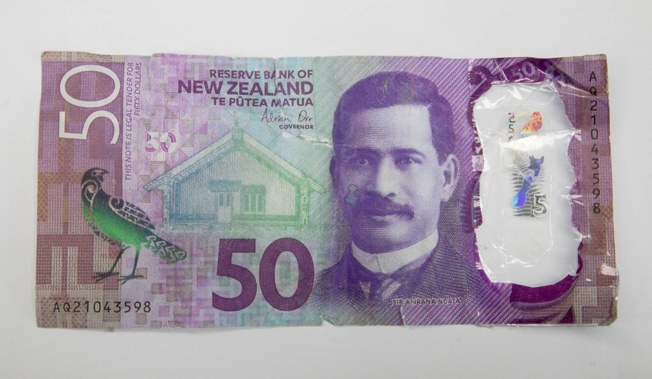
Police say counterfeit money, most commonly $50 bills, is circulating in Rotorua and, in one case, was used to buy $300 worth of goods.
It comes after businesses reported finding counterfeit money being used in Rotorua and the Bay of Plenty.
Rotorua area prevention manager Inspector Phil Gillbanks told the Rotorua Daily Post police were aware of counterfeit money being used in the area.
“Police have had a number of reports of counterfeit notes being presented in the Rotorua area over the past month, with one case totalling $300 of goods obtained using counterfeit notes.
“Various notes are circulating and being used, however, the predominant note is the $50 note.”
Gillbanks said police were following positive lines of inquiry and inquiries were ongoing.
He said police had charged a man with possessing forged bank notes after allegedly finding three counterfeit notes in a vehicle during a routine traffic stop in Rotorua earlier this month.
Gillbanks said it was important businesses that handled cash were aware of security features in New Zealand bank notes.
“I encourage all retail staff to be particularly vigilant when handling any cash notes and check carefully when completing transactions,” Gillbanks said.
He said retail staff should not accept suspicious notes.
“Note the description of the person and any vehicles they are using, then notify police.
“If you find you’ve already received a counterfeit note, put it in an envelope to avoid handling it further and get in touch with police.”
The comments come after Bay businesses spoke out about the fake money and how tricky it could be to spot.
Ngongotahā Bottle-O owner Charanjit Dhillon said counterfeit $50 and $100 notes were used at his store.
Ngongotahā Bottle-O staff member Namdeep Singh with a counterfeit $50. Photo / Andrew Warner
Dhillon said the fake money was paper and the see-through plastic part was cut from a $5 note and stuck on with tape.
“They’ve done a really good job. If you’re in a rush, you won’t know the difference.”
Counterfeit money has also been used in the Western Bay of Plenty where one Pāpāmoa business owner is no longer accepting cash over $50 unless the manager approves it.
The business owner, who spoke on condition of anonymity, said for the past three weeks there had been warnings by other businesses about the fake money and it appeared to be “an ongoing problem”.
Gillbanks said if members of the public have any information about these counterfeit notes or know of anyone who might be involved in their manufacture or distribution they could phone Police on 105 or give information anonymously through Crimestoppers on 0800 555 111.
How to spot a fake banknote:
Look
- See if it glows. Forgeries often glow under ultraviolet light while genuine notes don’t.
- Look for microtext. Using a magnifying glass, look at the numeral on the front and back of the banknote. There is microtext including “RBNZ” on the front in both series.
- Check for ink runs. Polymer banknotes and their inks are water resistant so should not have any blotches or running of the inks.
Feel
- Feel for rough. Polymer banknotes have raised printing, which can be felt when you run your fingers over them.
- Feel for the smooth. The notes are smooth and made of one piece of plastic and they shouldn’t tear easily.
Source: Reserve Bank of New Zealand
- Maryana Garcia, BoP Times
Take your Radio, Podcasts and Music with you

/cloudfront-ap-southeast-2.images.arcpublishing.com/nzme/FF6A24EKTZHFDABDUXYDEUZ5XU.JPG)








